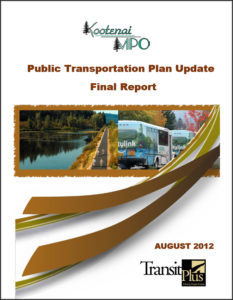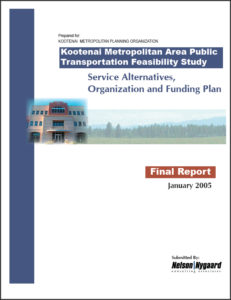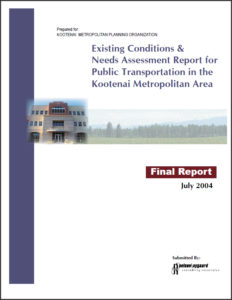As a metropolitan planning organization, KMPO is responsible for overseeing public transportation plans. Kootenai County serves as the designated recipient for FTA funds.
Transportation is vital in connecting our citizens to their communities and our region. With coordinated transportation services, providers are able to become more efficient and provide better service. This Plan also takes into consideration those with disabilities, low income and older individuals whose mobility may become particularly challenging.
The Coordinated Public Human Transportation Plan 2017 to 2020 serves two purposes:
First, it serves as a framework to improve coordination among transportation service providers and human service agencies to enhance transportation services for the community, but in particular, the transportation challenged populations. Second, this document meets federal requirements for a “locally developed, coordinated human services transportation plan” –or Coordination Plan – that includes the following elements:
- An assessment of available services that identify current transportation providers (public, private, and non-profit);
- An assessment of transportation needs for individuals with disabilities, older adults, and people with low incomes. This assessment includes experiences and perceptions of the planning partners as well as more sophisticated data-collection efforts (Intelligent Transportation System (ITS), and current gaps in service;
- Strategies, activities, and/or projects to address gaps between current services and needs as well as opportunities to achieve efficiencies in service delivery;
- Priorities for implementation based on resources, time, and feasibility for implementing specific strategies and/or activities identified.
Core requirements of these Coordinated Public Transit/Human Service Transportation Plans include:
- An assessment of transportation needs for veterans, individuals with disabilities, older adults, and persons with limited incomes;
- An inventory of available transportation services identifying areas of redundant service and gaps in service; strategies to address the identified gaps in service;
- Identification of coordination actions to eliminate or reduce duplication in services, and strategies for more efficient utilization of resources;
- Prioritization of implementation strategies…[read more].
KMPO is the organization creating the Kootenai County Coordinated Public Transit Human Services Transportation Plan. The majority of the 2010 update comes from the local Idaho Mobility and Access Pathway (IMAP) effort. In 2008, the Idaho Department of Transportation’s (ITD) Division of Public Transportation (Division) initiated a process to assist local mobility stakeholders across the state in developing a structure and process to create the first generation of mobility planning documents-Idaho’s Mobility and Access Pathway or IMAP. The Division continues to incorporate input received by the State, its advisory bodies, county and local government, regional planners, local communities, and the many diverse stakeholders respective to mobility management issues and activities throughout Idaho.
The 2010 Public Transit Human Services Transportation Plan is available as a pdf in the single page layout.
The KMPO is the organization creating the Kootenai County Human Services Transportation Plan. The information gathered was obtained during a series of telephone interviews. During the last week of April 2004, a consulting company hired by the KMPO conducted a random general public telephone survey to assess Kootenai County resident opinions of transportation, public transportation needs, and awareness. Using random dial calling, 402 households were sampled in Kootenai County. This level of sampling provides statistically reliable results at a 95% confidence interval for dichotomous questions (+/-5% margin of error). Survey respondents were questioned on household demographics, commutes to work and/or school, awareness and use of public transportation, and several other issues related to transportation and public transportation.
The 2007 Public Transit Human Services Transportation Plan is available as a pdf in the single page layout.
The Kootenai Metropolitan Planning Organization (KMPO) contracted for the 2012 study as part of their responsibility in overseeing planning and federal funding for transportation projects in the county. KMPO’s 11-member board provided guidance at key points in the study and is responsible for adopting the final plan. In addition, a study advisory committee provided a more detailed review of work products and additional comments to the consulting team. The consulting team worked closely with Citylink and Kootenai County transit staff in the development of the plan.
This study updates the Kootenai Metropolitan Area Public Transportation Feasibility Plan, adopted in 2005. The focus of the original study was on the development of public transportation services. This included short and long-term service options for the community based on conditions at the time and anticipated growth. Citylink public transit service was initiated in 2005 and ridership quickly grew to over 500,000 annual trips. Citylink is operated by the Coeur d’Alene Tribe and funded primarily by Tribal funds and Federal Transit Administration urbanized area funds. Kootenai County serves as the designated recipient for the FTA funds. While the focus of the 2005 plan was the feasibility and initial development of transit service, this update identifies the progress made since the last report and emphasizes the institutional and financial structure necessary to sustain the system and provide for a strong and responsive decision-making process.
The 2012 Public Transportation Plan Update Final Report is available as a pdf in the single page layout.

The 2005 Kootenai Metropolitan Area Public Transportation Feasibility Study marked an important step in the development of a multi-purpose, multi-modal transportation system in Kootenai County. This planning study provided the baseline for the implementation of a new public transportation network that would support resident needs for reliable and convenient alternatives to automobile travel. Travel in Kootenai County is primarily by private car and will continue to be so in the future. However, as the population grows congestion will worsen and the diversity of trips by purpose and time of day will increase. As these events unfold, other transportation solutions will become more and more important. As part of an efficient transportation system, transit can do more than provide just a transportation alternative. A strong transit network can improve the quality of life in Kootenai County by connecting people with jobs and services as well as attracting new jobs and services to the region. A solid countywide transit infrastructure will make it easier for people to transition from welfare to work and will help attract major employers to the region.
The Kootenai Metropolitan Area Public Transportation Feasibility study commenced in January 2004. The first deliverable, called Existing Conditions and Needs Assessment, assessed existing services and unmet transit needs in Kootenai County. This report included details on operations and ridership for existing services as well as data on land use patterns, current development activity, and other contextual information. The findings were based upon inputs from a range of stakeholders, agency and provider staff, policymakers and interest groups.
This Service Alternatives, Organization and Funding Plan is the second major deliverable. This report presents two service scenarios: (1) a short-term (five-year) scenario that assumes no growth in funding during the first year and marginal growth over the next four years; and (2) a long-term scenario that envisions an optimal public transportation network for Kootenai County. In addition, the plan discusses the best governance structure and service delivery model to support these services. It also details available funding needs and opportunities for raising new funds.
Building from a minimal funding base and lifeline transit network, the plan provides both short-term (five-year) and long-term (20-year) recommendations for meeting public transportation needs. Implementation of the plan is dependent on new local funding to expand service and to match available Federal Transit Administration grant funding. Governance, organization and staffing strategies are included to create a stable and reliable authority to promote funding and development of public transportation programs in Kootenai County.
The 2005 Kootenai Metropolitan Area Public Transportation Feasibility Study is available as a pdf in the single page layout.

